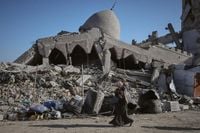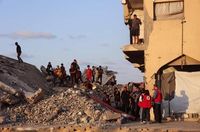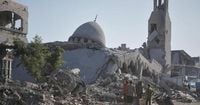In the fraught landscape of Gaza, the search for closure—both literal and symbolic—continues under the terms of a fragile ceasefire. On October 10, 2025, a U.S.-brokered agreement took effect, compelling Hamas to return the remains of all Israeli hostages as soon as possible. In exchange, Israel agreed to return 15 bodies of Palestinians for each Israeli hostage recovered. Yet, as the days stretch on, the process has proven to be anything but straightforward.
According to the Associated Press and other international outlets, the Palestinian group Hamas announced on Sunday that it had expanded its search for the bodies of the remaining Israeli hostages to new areas of the Gaza Strip. This move came just a day after Egypt stepped in, deploying a team of experts and heavy machinery—including excavators and bulldozers—to assist in the painstaking effort to retrieve the bodies. Egyptian officials, speaking anonymously, confirmed the arrival of the convoy in southern Gaza, specifically in the city of Khan Younis, where children and adults alike watched the heavy equipment claw through sand and rubble near buildings battered by war.
Under the terms of the ceasefire, Hamas is expected to return all the remains of Israeli hostages without delay. So far, Hamas has returned the remains of 15 hostages, but none in the past five days, a lull that has sparked frustration and international scrutiny. Israel, for its part, has returned the bodies of 195 Palestinians, many of whom remain unidentified. The exchange is part of a broader effort to bring some measure of resolution to families on both sides, but the process is hampered by the sheer destruction wrought by two years of conflict.
Hamas’ chief in Gaza, Khalil al-Hayya, stated on Sunday that the group had begun searching new areas for the bodies of the 13 hostages still unaccounted for. Al-Hayya, who also serves as the group’s top negotiator, attributed the difficulties in recovery to “the massive destruction, burying them deep underground.” This sentiment was echoed in comments shared with Egyptian media, underscoring the grim reality that many of the bodies are not only hard to reach but may also be irretrievable due to the scale of devastation.
The international community is watching closely. U.S. President Donald Trump issued a stern warning on October 25, declaring via social media, “Some of the bodies are hard to reach, but others they can return now and, for some reason, they are not.” He added, “I am watching very closely” and called for Hamas to return more bodies within the next 48 hours. Trump’s remarks reflect mounting impatience among mediators and underscore the high stakes of the ongoing ceasefire.
The ceasefire itself remains tenuous. On the night of October 25, Israeli forces struck the central Nuseirat refugee camp in Gaza, claiming to target militants associated with the Palestinian Islamic Jihad group who, according to Israeli military statements, were planning attacks on Israeli troops. Islamic Jihad, the second-largest militant group in Gaza, denied these allegations. The strike wounded several people, according to Al-Awda Hospital, and drew immediate condemnation from Hamas, which labeled it a “clear violation” of the ceasefire agreement. Hamas accused Israeli Prime Minister Benjamin Netanyahu of attempting to sabotage U.S. efforts to end the war.
Netanyahu, addressing his Cabinet on Sunday, defended the military’s actions, insisting, “Of course, we also thwart dangers as they are being formed, before they are carried out, as we did just yesterday in the Gaza Strip.” He further emphasized that Israel remains in charge of its own security, pushing back against accusations that the Trump administration is dictating Israeli policy in Gaza. Vice President JD Vance, during a recent visit, denied any such speculation, reinforcing Israel’s autonomy in its security decisions.
This latest strike in Nuseirat was not an isolated event. On October 19, Israel launched dozens of strikes across Gaza after accusing Hamas militants of killing two Israeli soldiers. That day’s attacks resulted in the deaths of at least 36 Palestinians, including women and children, according to local health authorities. The Gaza Health Ministry, whose casualty records are regarded as generally reliable by U.N. agencies and independent experts, reports that more than 68,500 Palestinians have died in two years of war triggered by the Hamas-led attack on Israel on October 7, 2023. Israel disputes these numbers but has not provided alternative figures.
While the ceasefire was intended to halt hostilities and facilitate humanitarian relief, the reality on the ground remains dire. The United Nations and its partners continue to urge Israel to allow more humanitarian aid into famine-stricken Gaza. Complicating matters, international media remain largely barred from Gaza, except for brief, tightly controlled visits with the Israeli military. Israel confirmed on Sunday that this policy has not changed, limiting independent verification and reporting from the conflict zone.
Meanwhile, efforts to stabilize and rebuild Gaza are underway, albeit in fits and starts. Around 200 U.S. troops are working alongside the Israeli military and delegations from other countries at a new coordination center. Their mandate: to oversee the ceasefire and plan for Gaza’s eventual stabilization and reconstruction. U.S. officials have been clear that none of these troops will operate on the ground in Gaza itself. Recent visits by Secretary of State Marco Rubio, Vice President JD Vance, and envoys Steve Witkoff and Jared Kushner underscore the international community’s investment in the ceasefire’s success. Rubio noted that Israel, the U.S., and other mediators are “sharing information to disrupt any threats,” adding that this cooperation recently helped identify a possible impending attack.
Despite these efforts, the road ahead is littered with obstacles. More complicated steps remain, including the disarming of Hamas and the establishment of a postwar governance structure for Gaza. The fate of the hostages, the ongoing exchange of bodies, and the sporadic violence all serve as stark reminders of how fragile the current peace truly is.
As the machinery grinds away in the rubble of Gaza and negotiators shuttle between capitals, the world waits to see whether this ceasefire will hold—or whether it, too, will be buried beneath the weight of history and grief.


